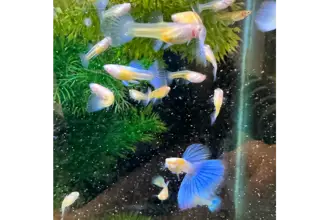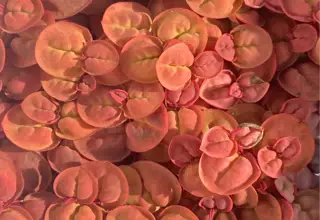Nymphoides Hydrophylla Plant Care: Everything You Need To Know
Posted by Miles Harrison on 10/14/2022
We use affiliate links and may receive a small commission on purchases.
Nymphoides hydrophylla plants are a great option for aquarists interested in adding real vegetation to their aquarium. These plants are quite hardy and look great in a freshwater tank.
In this guide, we’ll teach you all there is about caring for Nymphoides Hydrophylla plants and go over some of the benefits that this wonderful plant brings to the hobby.
January's Giveaways on Light Fish
Species Summary
Also known as Taiwan Lilies (Nymphoides hydrophylla ‘Taiwan’) is a gorgeous aquatic plant that is great for beginners new to aquatic plant keeping. This plant's unique leaves fan out and create an underwater canopy that will be enjoyed by your aquarium inhabitants.
This plant is ideal for aquariums that house peaceful species, such as Purple Moscow Guppies or Cardinal Tetras. It will also co-exist with other gentle species, such as a Galaxy Koi Betta.
This species is native to southern Taiwan, where waters are slightly acidic, and temperatures tend to be a bit on the warm side. Variations of the species also exist in parts of Asia and Africa, where its typically found in slow-moving streams and other bodies of water.
Nymphoides hydrophylla are a very adaptable species. They are capable of transitioning to more alkaline conditions, which is great for aquarists that live in urban environments where tap water tends to be a bit on the hard side. It’s no wonder why aquarists often recommend this easy-to-care-for plant.

The Benefits Of Having It In Your Tank
Similar to other aquatic plants, Taiwan Lilies can dramatically improve water conditions in a freshwater fish tank.
These plants are fast-growing and will consume nitrates and ammonia produced by fish waste. Taiwan Lilies take advantage of these compounds and use them to grow! When the plants photosynthesize, they also release oxygen into the water, resulting in a much healthier environment for your tank inhabitants.
Taiwan Lilies are also an attractive plant to look at! They make a great option for a background plant in nano tanks and can serve as an excellent midground plant in larger aquariums. If you have plastic plants, you will be stunned by the naturally-occurring green colors this plant produces. You may never go back to plastic plans again after purchasing a Taiwan Lily!
Nymphoides hydrophylla plants also serve a functional purpose for fish and shrimp. You may occasionally find a fish resting on its wide leaves, or a shrimp resting near the base of this plant. It provides plenty of coverage for species that like to stay out of the spotlight.
Appearance
Nymphoides hydrophylla plants have wide leaves that resemble traditional water lilies. Their fragile stems will often develop side shoots. These side shoots will produce new roots that extend to the substrate. The plant will grow from a rhizome, which is responsible for reserving food materials to nourish the plant.
The Nymphoides hydrophylla plant has a light-green color and under intense lighting, is quite vibrant. It will easily stand out even amongst other green-colored aquarium plants.
If you have red aquarium plants the Nymphoides hydrophylla plant will create a nice contrast. There’s a reason why this plant shows up in tanks entered in competitions!
You’ll know an unhealthy plant when you see one - its colors will appear dull, the tips of the leaves may start to turn yellow, or worse, it might start to endure necrosis.
Size & Growth Rate
Given optimal conditions, this plant can grow to be quite large! These plants can grow to about 10 inches in length. Unlike other large plants, these plants will not grow out of the water. Their large lily-like leaves will stretch across the surface, soaking up all sources of light. Typically once this species has reached the surface, is when you might start seeing side shoots starting to emerge. Don’t be alarmed! This means your plant is healthy, and you may soon be able to propagate this plant!
These plants are fast-growing, even under moderate lighting, once they’ve fully adapted to your water conditions, they can take off quite quickly. Luckily, these plants don’t require high light. If you’re looking to grow this plant at a slower rate, you can reduce the duration of light, as well as the light intensity.
Taiwan Lilies will also undergo a transition period when introduced to a new aquarium. Don’t be surprised if it takes a few months for this plant to get established in your aquarium. Typically, it will take a plant 3-5 weeks to fully transition to a new aquarium. It’s perfectly normal if the plant looks unhealthy during this period.
🛒 Shop Freshwater Fish on Light Fish
Nymphoides Hydrophylla Care
Taiwan Lilies are a popular freshwater aquarium plant for a reason. They’re some of the easiest plants to take care of and are often recommended to new hobbyists looking to venture into planted aquariums.
Like every plant, Taiwan Lilies still come with some minor challenges. Let’s go over these in a bit more detail so that your plants will be well taken care of.
Tank Size
If you plan on adding Nymphoides Hydrophylla to your aquarium, we recommend having a tank that’s at least 10 gallons. Experienced aquascapers are probably aware that these plants can grow in a tank that’s virtually any size, but we recommend 10 gallons due to this plant's high rate of growth.
Given proper conditions, this plant can quickly cover a small aquarium. If you’re after a jungle-like appearance, this might be preferred. However, if you prefer to just keep a small section of Taiwan lilies, keeping them in a larger tank will require less pruning.
Since these plants grow vertically, you may want to consider a vertically oriented tank. It’s quite interesting seeing these plants grow to their full height!
Water Parameters
Since Nymphoides Hydrophylla is native to warmer waters, for the best rate of growth, you’ll want to make sure you have an aquarium heater. Temperatures should be kept a bit on the warmer side, and we recommend keeping them between 75-80°F. You can ensure these temperatures remain consistent by purchasing a trusted aquarium thermometer .
If you’re interested in keeping this plant species in cooler temperatures, you’re in luck! As these plants will adapt to temperatures as low as 68°F, although growth rates will likely be a bit slower.
This versatility is great for hobbyists, as the plant doesn’t require daily attention and care. Providing these parameters should set you up for success:
Water temperature: 68-80°F
pH: 6-8
KH: 6-12 dkH
Substrate
Substrate type isn’t very important for Nymphoides Hydrophylla, as these plants can grow quite well just by floating throughout the aquarium!
Any aquarium gravel should suffice, but we recommend nutrient-rich substrates, such as CaribSea’s eco-complete . These types of substrates will provide nutrients that your Taiwan Lilies will absorb.
Even though nutrient-rich substrates eventually lose strength over time, they provide extra nutrients that ultimately help prevent potassium or nitrate deficiencies.
Lighting
Taiwan Lilies are not very demanding when it comes to lighting. Aquarists have even successfully kept this species in sunlit-only tanks! Ultimately, we recommend at least 1-2 watts per gallon of lighting for this plant. Having a dedicated lighting fixture gives you much more control compared to natural sunlight.
If you want this aquarium plant to grow quickly, and show off its most vibrant colors, you can increase the intensity of your lighting. But be warned! Increasing the duration of your lighting period, or increasing the intensity of your lights can be a recipe for disaster, and you’ll most likely experience an algae bloom!
If you’re interested in increasing your lighting intensity, you’ll want to make sure you have a nutrient-dosing strategy, large biomass of existing plants, and a CO2 injection system to give this plant everything it needs to grow.
Nutrient Dosing
If you’re noticing that your Nymphoides Hydrophylla plant is beginning to melt, the number one culprit is a lack of nutrients. You’ll want to dose dry fertilizers or a liquid fertilizer solution such as Flourish.
Dosing nutrients 2-3 times a week, while doing 50% weekly water changes will give this plant everything it needs to succeed!
How to Plant It
Nymphoides Hydrophylla is a rosette plant, as its leaves radiate from a center stalk. Similar to most other rosette plants, you’ll want to expose some of the plant's growth tips where the leaves emerge. The plant’s roots can be completely buried, but this plant can also grow by just floating in the tank!
Typically, when these plants are purchased they will be bundled by their stems. Sellers will typically wrap a small piece of foam mesh around the roots, and then tighten the mesh via a flexible piece of metal or rubber bands.
Carefully remove the wrapping around the stems. If you’ve purchased this plant online, it will have most likely undergone some stress during transportation. Make sure not to damage the roots of the plant while unwrapping.
Once separated, you can bury the roots in the substrate. We recommend burying the roots at least 1-2 inches deep. You can also tie Taiwan Lilies to hardscape, such as stones or driftwood, by using a small piece of fishing line. Over time, as the plant establishes itself you can cut and remove the fishing line.
Technically, you don’t need to bury this plant, but we love the appearance it gives when it’s rooted along the back of an aquarium. Nymphoides Hydrophylla makes for an excellent backdrop in a planted aquarium.
🛒 Shop Aquarium Plants Fish on Light Fish
Trimming & Pruning
Over time, you’ll most likely need to trim and prune your Taiwan Lilies. These plants can grow quite tall, and can even grow quickly under high-light conditions. Some aquarists love to create a jungle-like appearance, but if you want a tidy tank, you’ll want to regularly trim and prune this species.
New hobbyists may think trimming a plant is harmful, but in fact, plants love to be trimmed! Regular trimming and pruning allow plants to propagate, and they will grow back with a much fuller appearance.
Luckily, trimming Nymphoides Hydrophylla couldn’t be easier. Trimming the stem, and then replanting the top half will produce more lilies. The portion of the stem that’s cut will heal itself and produce even more lilies! You can ensure you do a clean cut, by purchasing aquarium scissors . Aquarium scissors have long handles, giving you a lot more control when you're trying to perform a trim.
If needed, you can trim off side shoots, but if you’re looking to increase your plant biomass, let them grow! Eventually, these side shoots will sprout new plants!
We advise against trimming the leaves of the plant, as portions that are partially cut will not grow back. Eventually, the damaged leaf will melt away. If you need to trim the leaves of this plant, we recommend removing the entire leaf.
Tank Mates
Nymphoides Hydrophylla will do well with peaceful freshwater fish. You can add this plant with schooling fish, a single species tank, or a community tank. Since this plant prefers water to be on the warmer side, you’ll want to include fish that also prefer warmer temperatures.
Fish such as Otocinclus Vestitus, Cardinal Tetras, Neon Tetras, and Cloud Minnows are great options for a tank that houses Nymphoides Hydrophylla.
Peaceful invertebrates, such as Cherry shrimp and Orange Pumpkin shrimp are also excellent additions.
You can also add snails, such as mystery snails or assassin snails. These invertebrates will also munch on algae, keeping your plants looking nice and fresh!
You’ll want to avoid larger aggressive fish, such as African Cichlids. These fish are known to pick at and uproot plants. There’s nothing more frustrating than planting a Taiwan lily, only to have it uprooted by a fish!
Propagation
Propagation is straightforward with Taiwan Lilies. After a few leaves have formed on the plantlet, all you need to do is trim the stem. You can gently remove the lower portion of the cut stem from the crown of the plant.
After cutting, you can replant the stem into a nutrient-rich substrate. Over time, they’ll start to grow! Usually, plants will go through a small transition period after trimming, so don’t be surprised if you notice stagnant growth for a week or two.
Conclusion
Taiwan Lilies make an excellent addition to freshwater tanks. They look amazing, are easy to take care of, and have the added benefit of purifying the water in your home aquarium.
We highly recommend this plant for experienced and beginner hobbyists. Its versatility makes it one of our favorite aquarium plants, and if you decide to purchase one, we’re confident it will quickly become a favorite of yours as well.
We hope you enjoyed this plant care guide. If you notice we’ve made some mistakes, or have some feedback, we’d love to hear from you. Create a topic on our community forum and we’ll get back to you right away!
January's Giveaways on Light Fish














